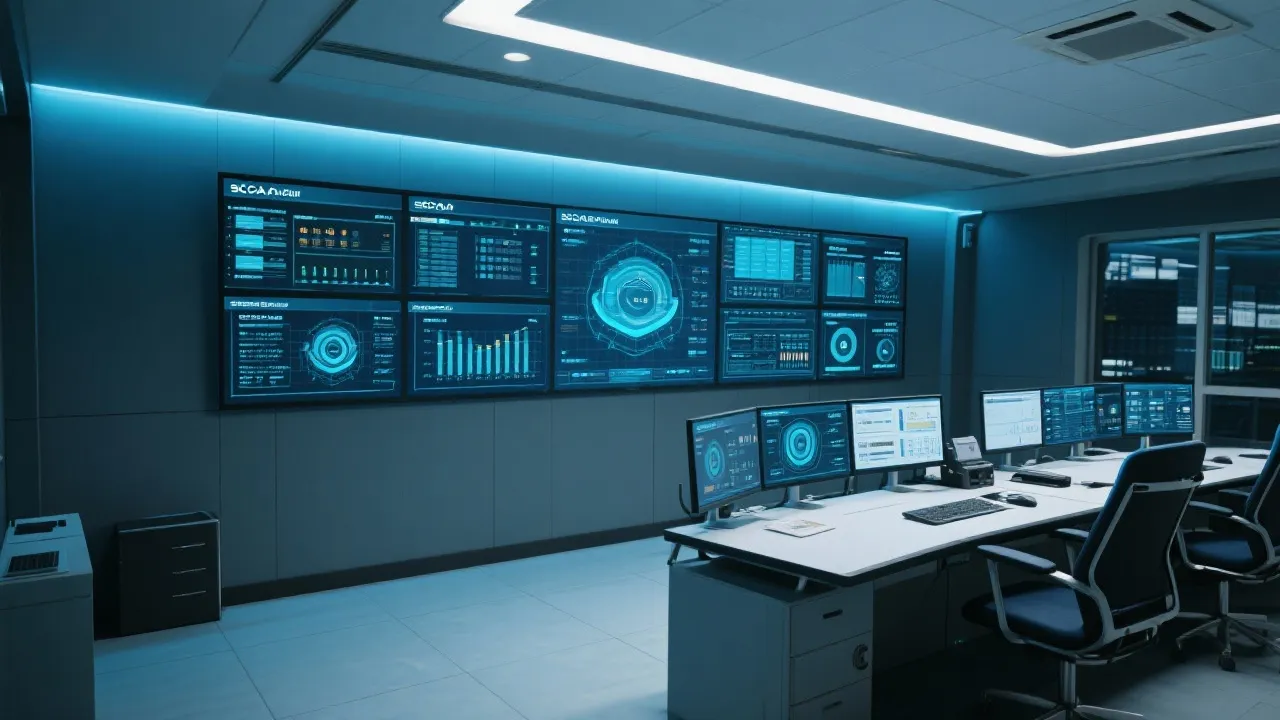IHM SCADA systems are crucial in modern industrial automation, providing real-time monitoring and control of plant operations. These systems help streamline operations, enhance productivity, and ensure safety by offering a detailed visualization of industrial processes. The integration of IHM SCADA not only boosts operational efficiency but also aids in preventive maintenance and energy management.

Understanding IHM SCADA Systems
IHM SCADA (Supervisory Control and Data Acquisition) systems represent a pivotal technology in the realm of industrial automation. They are designed to collect and analyze real-time data from various sensors and control systems across a facility, providing a detailed visual representation of the workings within a plant. By utilizing IHM SCADA, operators can observe and control the production processes in real-time, making timely decisions that enhance both process efficiency and operational reliability.
Components of IHM SCADA
IHM SCADA systems are composed of numerous critical elements that work together seamlessly to ensure efficient monitoring and control. The primary components include:
- Human Machine Interface (HMI): The user-friendly interface that allows operators to interact with the system. It displays graphical representations of facility operations, enabling quick assessment of status and alerts.
- SCADA Software: This software provides the tools necessary for data acquisition, system control, and data processing. Advanced SCADA software includes features for alarm management, historical data logging, and reporting functionalities.
- Remote Terminal Units (RTUs): These devices collect data from sensors installed in the field and transmit it back to the SCADA system. RTUs can operate independently and are crucial for remote monitoring applications.
- Programmable Logic Controllers (PLCs): PLCs execute control actions based on received data and feedback from sensors. They are essential for automating processes and ensuring corrective actions are undertaken when necessary.
- Databases: SCADA systems utilize databases to store the vast amounts of data collected from sensors and control devices for both short-term and long-term analysis.
- Communication Infrastructure: This includes various communication protocols like TCP/IP, MQTT, or proprietary protocols that facilitate data transmission between components of the SCADA system.
Benefits of Implementing IHM SCADA
Integrating an IHM SCADA system into industrial operations offers numerous advantages:
- Increased Operational Efficiency: Real-time data monitoring helps identify issues quickly and streamline processes, reducing downtime. With timely data insights, organizations can optimize their workflow and increase throughput.
- Enhanced Safety: Immediate alerts and comprehensive process visualization ensure that potential safety hazards are addressed promptly. By monitoring critical parameters, operators can make informed decisions to mitigate risks.
- Predictive Maintenance: By analyzing trends and patterns, SCADA systems can forecast equipment failures before they occur, optimizing maintenance schedules. This proactive approach reduces costs associated with unplanned repairs.
- Energy Management: By monitoring energy consumption, organizations can implement conservation measures and reduce operational costs. SCADA systems can provide insights on energy usage patterns, helping to identify inefficiencies.
- Improved Data Analysis: SCADA systems enable the collection and analysis of large volumes of data. The insights derived can guide strategic decisions, influencing everything from production schedules to supply chain management.
- Scalability: IHM SCADA systems can be easily expanded to accommodate additional sensors and devices, adapting to the growing needs of an organization as technology advances.
IHM SCADA Implementation Process
Implementing an IHM SCADA system involves several crucial steps to ensure seamless integration:
- Conducting a Comprehensive Needs Assessment: Understand operational requirements and key performance indicators (KPIs). Engaging with stakeholders across departments ensures all user needs are considered.
- Selecting Compatible Hardware and Software Components: Choose components based on scalability and compatibility with existing systems. Evaluating vendors for reliability and support is equally important.
- Designing an Effective HMI: Create a user interface that offers intuitive navigation and visibility. Custom dashboards can be designed to present data relevant to operators, improving response times to abnormal conditions.
- Integrating SCADA with Existing Control Systems: This includes configuring data exchange protocols and ensuring compatibility with legacy systems. Conducting rigorous tests is essential to ensure accuracy and reliability.
- Providing Training for Operators: Comprehensive operator training helps team members fully leverage the system’s functionalities, ensuring they can effectively manage the SCADA environment.
- Ongoing Support and Maintenance: Post-implementation support is vital. Regular updates, system checks, and user feedback loops can help mitigate issues as they arise.
- Continuous Evaluation and Improvement: After deployment, it is important to continuously monitor system performance and adjust configurations based on operational feedback to ensure the SCADA system evolves with changing requirements.
Common Challenges and Solutions
While implementing IHM SCADA offers significant benefits, some common challenges include:
- Data Security: Protecting sensitive data from cyber threats is crucial. Employing encryption, robust firewall solutions, and implementing strict access controls can bolster security measures.
- System Complexity: SCADA systems can be complex and overwhelming for untrained personnel. Providing continuous training and designing user-friendly interfaces are key to managing this complexity.
- Integration with Legacy Systems: Aligning SCADA with older systems can be challenging. Utilizing middleware solutions can enhance compatibility and facilitate data exchange.
- Reliability and Downtime: Ensuring system uptime involves regular maintenance and updates to both software and hardware. Planning for redundancy and backup systems is also crucial to minimize disruptions.
- Regulatory Compliance: Adhering to industry regulations and standards can be a challenge. It is essential to engage compliance experts during the design phase to ensure all regulatory requirements are met.
IHM SCADA: A Look Ahead
As industrial operations continue to evolve, IHM SCADA systems are likely to incorporate advanced technologies such as artificial intelligence (AI) and machine learning (ML) to further enhance operational efficiency and predictive capabilities. The growing trend towards smart factories and the Internet of Things (IoT) will play a pivotal role in shaping the future of SCADA systems. Enhanced AI algorithms could analyze data in real time, enabling more accurate predictions regarding equipment wear and failure rates.
Additional emerging technologies like edge computing will be significant for IHM SCADA systems, allowing for faster data processing closer to the source, reducing latency and bandwidth limitations associated with moving large datasets to a centralized server. The integration of mobile device capabilities will also empower operators to monitor processes remotely, enabling greater flexibility and responsiveness to production needs.
Moreover, innovations in cybersecurity are expected to play a major role in the evolution of SCADA systems as organizations seek to bolster their data protection strategies. As cyber threats grow more sophisticated, the adoption of advanced authentication mechanisms, continuous monitoring for anomalous activities, and automatic threat response systems will be vital.
FAQs
- What industries benefit the very from IHM SCADA systems? Industries such as manufacturing, oil and gas, utilities, water treatment, transportation, and smart buildings see significant benefits from integrating SCADA systems for operational control and efficiency. Specifically, manufacturers can leverage SCADA for real-time production insights and quality control, while utility companies can enhance grid management and outage detection.
- Can SCADA systems be customized? Yes, SCADA systems can be tailored to meet the specific needs of different industries and operational requirements. Custom solutions can include specific functionalities and integrations with other software systems.
- What is the typical lifespan of a SCADA system? With proper maintenance, a SCADA system can remain reliable and functional for up to 15-20 years. Regular upgrades and updates, however, are needed to keep systems current with technological standards.
- How do SCADA systems contribute to energy efficiency? SCADA systems can help track energy usage patterns in real time, allowing organizations to identify inefficiencies and wastage. With the right algorithms, they can provide recommendations for energy savings and integration with renewable energy sources.
- What are the main differences between SCADA and DCS (Distributed Control Systems)? While both systems are used in industrial control processes, SCADA is primarily used for long-distance monitoring and control, whereas DCS is generally used within a local environment for continuous processes. SCADA tends to focus on monitoring multiple sites, while DCS focuses on control at the plant level.
- How is data visualization accomplished in IHM SCADA systems? Data visualization in IHM SCADA systems involves graphical displays that represent real-time data. This can include charts, gauges, and maps that allow operators to see the status of various processes, facilitating better decision-making.
Conclusion
The integration of IHM SCADA systems within industrial operations is not merely a trend; it is poised to become a cornerstone of modern manufacturing and service delivery. By providing a comprehensive view of operational data, enhancing efficiency, and supporting predictive maintenance through advanced data analytics, IHM SCADA systems empower organizations to navigate the complexities of industrial automation. As technological advancements continue to evolve, these systems will play an increasingly vital role in shaping the operations of the future, helping organizations adapt to challenges, exploit new opportunities, and foster a culture of continuous improvement.









